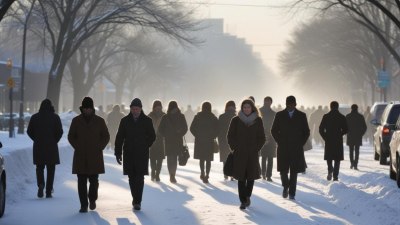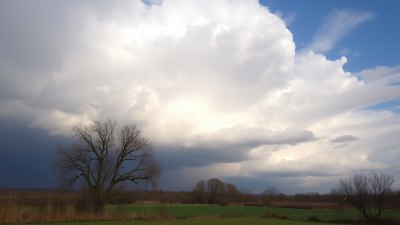How Cold or Warm Weather Shapes People’s Morning Commutes
Exploring the impact of weather on morning commutes and how it affects daily routines.

This image was created with the assistance of Freepik
Weather is an inevitable force of nature that influences many aspects of life, and one of the most significant effects it has is on people’s morning commutes. Whether it's the chill of a winter morning or the warmth of a summer day, the weather conditions can dictate not only how individuals commute but also their mood and productivity throughout the day. In this article, we will delve into how cold and warm weather alters commuting patterns, modes of transportation, and overall daily experiences.
The Impact of Cold Weather on Commuting
Cold weather can severely impact morning commutes in various ways. First and foremost, during freezing temperatures, people often opt for modes of transportation that require less exposure to the elements. For many, this translates into using cars instead of bicycles or walking to work. This tendency to drive increases traffic congestion, which can lead to longer commute times. Furthermore, cold weather can cause delays in public transportation systems, such as buses and trains, as snow and ice create hazardous conditions for both vehicles and tracks.
In regions where freezing temperatures are common, the integration of winter tires and vehicle maintenance become crucial for safe travel. The responsibility of clearing snow from sidewalks and driveways also falls on commuters, adding an extra layer of effort before even starting the day. As a result, many people adjust their schedules, leaving home earlier to account for the additional time required for navigating treacherous conditions.
Emotionally, cold weather can also have a significant impact on commuters. Exposure to low temperatures and dreary weather can lead to feelings of discomfort or even seasonal affective disorder (SAD), affecting one’s mood and attitude towards work. This mental state may influence productivity levels and overall job satisfaction, making it essential for employers to be aware of these fluctuations throughout the year.
How Warm Weather Affects Commutes
Contrasting cold weather, warm weather tends to bring about a more pleasant commuting experience, but it is not without its challenges. During the summertime, many individuals may choose to walk or cycle, taking advantage of the favorable conditions. Increased utilization of bicycles not only helps reduce traffic congestion but also contributes positively to physical health and well-being, allowing commuters to incorporate exercise into their daily routines.
The rise in temperature affects various factors associated with commuting. For instance, warm weather often sees a spike in tourist activity, which can further congest popular routes. Local businesses may also flourish during this season, adding to the number of pedestrians in urban areas, thus impacting travel times for all forms of transportation. Public transport may experience bumps in ridership; however, commuters may find the lack of air conditioning a detriment during sweltering days. The discomfort caused by heat can lead to irritability and dashed expectations for a pleasant start to the day.
Weather conditions like rain or heatwaves during summertime can also deter individuals from cycling or walking. The unpredictability of stormy weather can leave commuters scrambling for alternative modes of transportation at the last minute. Additionally, persistent heatwaves may spark discussions about climate change and the long-term implications of rising temperatures on daily routines and transportation infrastructure.
Psychological Reactions to Different Weather Conditions
An intriguing aspect of commuting is how psychological reactions to weather conditions can manifest differently for individuals and communities. Colder months can push people to focus more on logistics, such as ensuring they dress warmly, while warmer months might bring an air of relaxation and a more leisurely pace. For some, cold weather is seen as a hurdle to overcome; for others, it provides a sense of challenge or adventure. How individuals interpret their commuting experience sets the stage for a unique morning ritual.
Moreover, social interactions during commutes can vary across weather experiences. Cold weather may lead to fewer outdoor gatherings or social meetups, whereas the warmth of summer might incite more conversations among neighbors and an increased presence in public spaces. Such social dynamics influence community-building and establish connections between commuters, offering glimpses into societal fabric affected by climatic conditions.
The Role of Technology in Weather-Related Commuting
Technology has increasingly come to play a vital role in addressing commuting challenges linked to weather conditions. Mobile applications provide real-time updates on weather forecasts, public transportation schedules, and traffic updates, helping commuters make more informed decisions. Users can adapt their travel habits accordingly, such as leaving earlier when snow is predicted or opting for different routes based on congested areas.
Furthermore, advancements in electric vehicles and hybrid technology allow for greener transportation options, minimizing the environmental impact of increased vehicle usage during colder months. Ride-sharing services help mitigate congestion and provide more flexibility when harsh weather impacts mass transit. Commuters can share rides, reducing the number of vehicles on the road and easing traffic during inclement weather.
Adapting to Seasonal Changes in Commute Strategy
Embracing the changing seasons can yield new strategies for enhancing one’s commute. As weather transitions from cold to warm, utilizing different modes of transport can reveal richer experiences. Incorporating walking and cycling into the daily commute can have numerous benefits, such as boosting energy levels and providing a sense of rejuvenation that ultimately prepares individuals for a productive day.
Employers can also facilitate such adaptive changes by offering incentives for employees to use alternative forms of transportation. Initiatives such as subsidizing public transport passes or providing safe bike storage can encourage individuals to consider options other than driving. These adaptations not only improve personal health but also contribute to broader sustainability efforts aimed at reducing greenhouse gas emissions.
Future Trends in Commuting and Weather Influences
As cities continue to evolve, the impact of weather on commuting is expected to gain more attention. Urban planners are increasingly incorporating weather resilience in their designs, focusing on sustainable transport solutions that accommodate various climate conditions. Research into urban heat islands, flood-prone areas, and cold weather impacts shapes how cities plan their infrastructures to maintain accessibility year-round.
Additionally, trends towards remote working due to climate conditions may alter commuting habits significantly. If companies encourage employees to work from home during extreme weather, the traditional concept of commuting could shift dramatically. This evolution opens discussions about future city designs that promote mixed-use developments and climate-sensitive planning.
In conclusion, weather plays an undeniable role in shaping people’s morning commutes. Cold and warm weather conditions affect not just how individuals travel but their overall mood and productivity. Understanding these dynamics is essential for commuters, employers, and city planners alike. By acknowledging the impacts that weather has on our daily routines, we can better prepare for the future and create more adaptable commuting experiences that consider our environment and individual needs.











